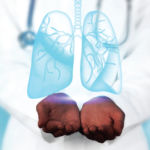
FGC / shutterstock.com
Interstitial lung disease (ILD) can be associated with rheumatoid arthritis (RA) with significant morbidity and mortality. An article in The Journal of Rheumatology focused on calculating the prevalence, incidence, mortality and costs to the healthcare system of RA-related ILD (RA-ILD).1
“RA is the most common of connective tissue diseases encountered by rheumatologists—affecting about 1% of the adult population—and ILD is a known common manifestation,” says author Aryeh Fischer, MD, associate professor of medicine at the University of Colorado School of Medicine, Aurora. “We thought it would be important to learn about prevalence of ILD in RA and get a better sense of its economic burden.”
Insurance Databases Used
Dr. Fischer and others undertook a retrospective analysis of Truven Health MarketScan Commercial and Supplemental insurance databases from 2003–2014. These have more than 150 million covered lives across all geographic regions of the U.S. and include a variety of plan types. The researchers also included the Social Security Administration death database.
Patients were identified as potential RA-ILD cases based on data from medical claims, such as respiratory disease-related International Classification of Diseases, ninth edition, Clinical Modification (ICD-9-CM) codes. The date of the earliest claim was defined as the index date.
Cost data were obtained from patients who were continuously enrolled for 12 months after the index date. Healthcare use and costs were measured over a five-year term for those patients with 60 months of continuous enrollment. There were no continuous enrollment criteria for mortality.
Outcomes
Outcomes measured included one-year prevalence and incidence of RA-ILD in the general enrollee population. They also measured all-cause and respiratory-related healthcare costs reported in 2014 U.S. dollars. Finally, the researchers included all-cause survival for a subset of newly diagnosed patients for whom vital statistic information was available.
During the 10-year study, the number of patients meeting the criteria for inclusion ranged from 892 to 3,232 patients per year. Prevalence of RA-ILD varied across the 10-year period between 3.2 (95% confidence interval [CI]; 3.0–3.4) and 6.0 cases per 100,000 people (95% CI; 5.7–6.2). Incidence rates ranged from 2.7 (95% CI; 2.5–2.9) to 3.8 (95% CI; 3.5–4.0) per 100,000 people.
Prevalence Decreasing/Incidence Stable
Over time prevalence appeared to be slowly increasing while incidence remained relatively stable. The increased prevalence suggested to the researchers an increase in duration of RA-ILD, which they attributed to improved survival. They also noted that it could mean newer therapies are more effective and/or increased disease awareness has led to patients being diagnosed earlier in the course of the disease.
There were 750 patients with five years of follow-up data. During that time, 72% of participants had an inpatient admission and 76% were seen in an emergency department. Mean total five-year costs were $173,405 per patient (standard deviation [SD] $158,837). Annual per-patient costs were highest in years 1 and 5. Five years following the initial diagnosis, 35.9% of patients were still alive.
“The vast majority of patients (over 70%) had evidence of hospitalization and [emergency department] visits over a five-year period. We also found the disease is costly to the healthcare system,” says Karina Raimundo, MS, another author and principal health economist for Genentech. “More importantly, in our study we found the median survival from first evidence of evidence of diagnosis was 7.8 years. By comparison, a 65-year-old (the mean age of RA-ILD patients in the study) in the United States is expected to live another 19 years.”
Average Healthcare Costs
The average yearly all-cause healthcare costs ranged from $40,941 (SD $55,682) to $51,849 (SD $77,125). The median all-cause healthcare costs ranged from $28,021 (interquartile range [IQR] $13,314–49,879) to $31,914 (IQR $13,563–56,180).
The main drivers of cost were inpatient admissions, other outpatient services and outpatient pharmacy. Each year, between 13.6% and 19.5% of patients were hospitalized with respiratory-related diagnoses. In addition, 13.7% to 19.4% were seen in the emergency department for respiratory complaints. Average yearly respiratory-
related costs ranged from $8,944 (SD $21,021) to $14,008 (SD $65,346). These alone accounted for 18.5–29.4% of total all-cause costs.
Limitations Noted
The authors note limitations to consider. Using the claims-based MarketScan Research Database, they relied on claims data for clinical details based on ICD-9-CM coding rather than clinical information from medical records. Misclassifications may have occurred. Their use of multiple diagnoses may have excluded some true cases of RA-ILD leading to underestimates of prevalence. The date of diagnosis wasn’t available, meaning some previously diagnosed cases may have been classified as incident cases.
“Our results highlight that ILD is a very important manifestation of RA,” says Dr. Fischer. “It impacts morbidity, survival and has an economic impact on society. We believe these results highlight the need to assess for ILD in RA and point to a need to identify therapies to alter the natural history of RA-ILD.”
‘Surprisingly High Healthcare Costs’
Tracy Doyle, MD, MPH, is an assistant professor at the Harvard Medical School and a physician in Pulmonary and Critical Care Medicine at Brigham and Women’s Hospital in Boston. She says this is an important study for many reasons. “It was surprising how significant healthcare costs were,” she says. “It was something a lot of us who do research and treat these patients had expected, but actually seeing it validated in print was very helpful.”
She thinks these results will help increase interest in and research into better understanding those with RA-ILD to treat, prevent and hold down costs associated with the disease.
Moving in the Right Direction
“Another thing that I found very interesting was that although the prevalence has been increasing, the incidence has stayed stable,” she says. “This is telling me that we are already moving in the right direction. The prevalence is up probably because we are finding RA-ILD sooner and people are living longer with it—something the authors hypothesized as well.”
She also noted the mortality was consistent with other studies showing around one of three patients dying within five years of diagnosis. This was not a surprising outcome and validated that although treatment has come a long way, we still need better options.
“I think this is a very impressive study,” says Dr. Doyle. “It has some very good information for those involved in healthcare finance, and from a clinical standpoint, this validates there are many people with RA-ILD and they have a lot of healthcare needs. We need to figure out how to find RA-ILD earlier so we can prevent and treat it better. Hopefully, this will help justify requests for research money to do just that.”
Kurt Ullman has been a freelance writer for more than 30 years and a contributing writer to The Rheumatologist for more than 10 years.
Reference
- Raimundo K, Solomon JJ, Olson AL, et al. Rheumatoid arthritis-interstitial lung disease in the United States: Prevalence, incidence, and healthcare costs and mortality. J Rheumatol. 2018 Nov 15. pii: jrheum.171315. doi: 10.3899/jrheum.171315.

